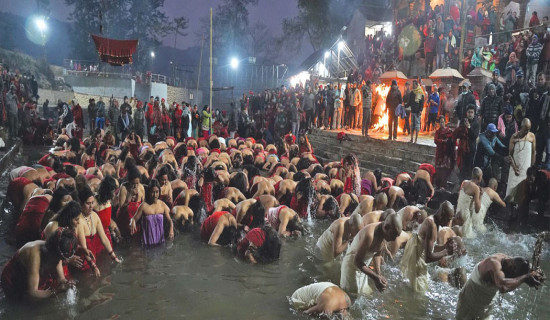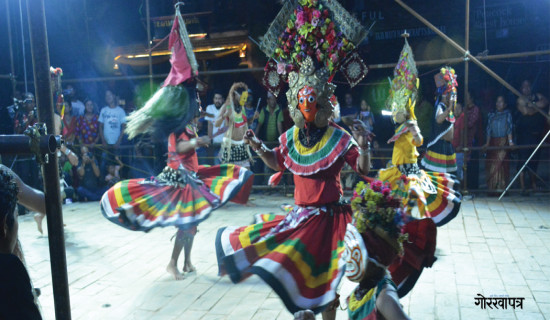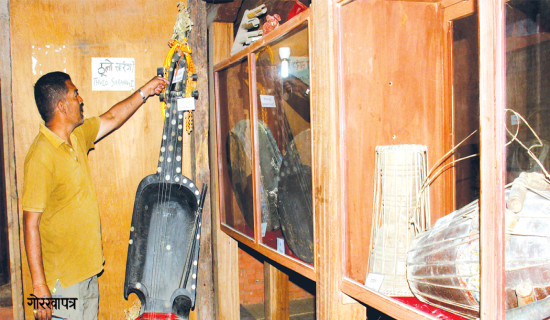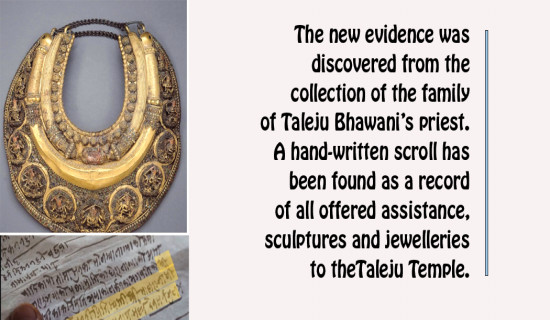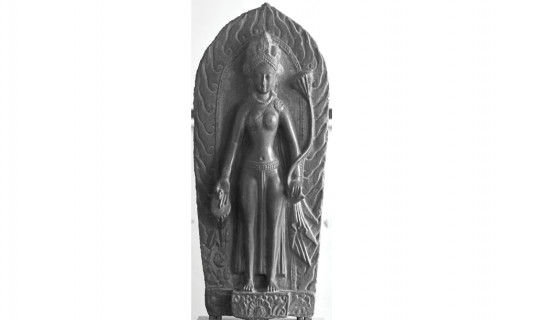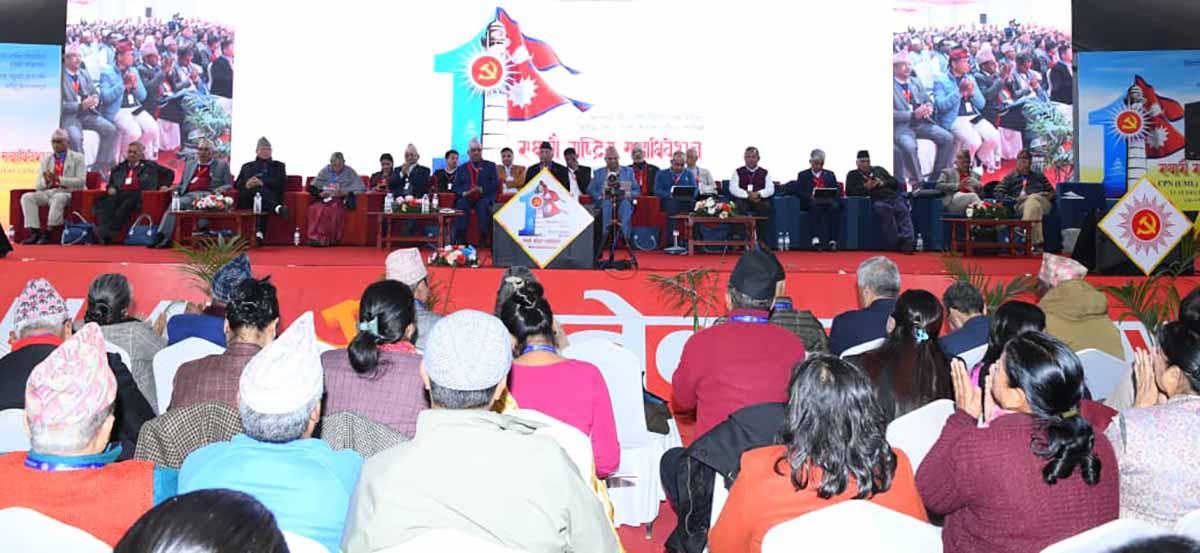- Monday, 15 December 2025
Launching of satellites delayed in absence of VC at NAST
The Nepal Academy of Science and Technology (NAST) has developed two more satellites after the success of its first nanosatellite project.
Vatsaleshwori Jatra of Pashupati gets underway
Among various jatras and festivals, which are celebrated in the Pashupati area since ancient times, Vatsaleshwori Jatra is one. It is the longest jatra of the Pashupatinath area, and the process to mark this annual festival began on Tuesday by performing Dudu Chya Chya (invitation journey).
As Maghe Sankranti nears, Tokha ramps up Chaku production
Kids love it, adults like it too; the mouth-watering delicacy Chaku is a favourite of all. And with the unofficial Chaku day – Maghe Sankranti – just two days away, factories in Tokha, Kathmandu, are now running at full capacity to supply the chocolate-coloured sweet stuff to the markets of Kathmandu Valley and beyond. Tokha, located in the northern edge of the valley, is the C
Swasthani fasting begins
Lord Kumar dictates: Oh, sage Agastya …This phrase shall once again be heard in houses of the faithful across the Kathmandu Valley and beyond as the Swasthani fast has begun.
Building heritages back traditionally
Rapid and haphazard urbanisation had already been claiming the natural and cultural heritage of Kathmandu Valley and the adjoining cities for decades when the 2015 earthquake struck and further destroyed the centuries-old temples, shrines and public shelters in the region.
How repatriation of an idol can help restore a conduit
Kathmandu, Dec. 6: For decades now, haphazard urbanisation, government neglect and public apathy have been causing many of Kathmandu Valley’s ancient water spouts, or Hitis as they are known in the native Nepal Bhasa, to dry up or get destroyed, covered or buried. One such buried spout is Bungamati’s Bahili Hiti in Kotatole, Lalitpur Metropolitan City–22.What happened to the Hiti is peculiar and it’s a story that must begin with a look at the Vishnu statue that is presently on its way back to Nepal from nearly three decades of coerced stay in the United States.The holy statue has been in the States since at least 1995, when it supposedly reached the Metropolitan Museum of Arts. It was stolen from Kotatole in the 1980s and presumably smuggled out of the country.The process of bringing the idol back started after the Facebook page Lost Arts of Nepal tracked it to the Museum last year. Following this discovery, the Nepal Heritage Recovery Campaign, an organisation which supports the government in bringing back lost and stolen heritage, moved the Department of Archaeology (DoA) to claim and repatriate the sculpture.Subhadra Bhattarai, chief archaeological officer at the DoA, said that the idol would be back in its home country soon.The 11th-century statue of Shreedhar Vishnu – Vishnu flanked by his divine energy (Shakti) Goddess Laxmi and his mount Garuda – was fixed to the base of a Lichhavi-era stupa at Kotatole before being stolen in the 1980s. A photograph by the late archaeologist Shukra Sagar Shrestha proves this.Now, we get to the Bahili Hiti. The Hiti, the stupa and the statue were all underground before 1960. Talking about the water conduit, local heritage lover Anil Tuladhar told The Rising Nepal that before the 60s, the only sign of the Hiti was in stories told by senior citizens.“Elders used to tell of a Hiti that existed near the Ganesh Temple here but no one had seen any of its structures physically,” Tuladhar said.But the stories were enough to prompt the youths of the tole to decide to excavate. Helped by the then village development committee, they dug up the ground and found the ‘Stone Tap’, dried up but structurally intact, 10 metres below the surface. The Lichhavi stupa was also on its subterranean premises, as were the ancient statues of the Shreedhar Vishnu, Uma Maheshwor, Kuber and Buddha.“But with the unearthing of the Hiti also came disputes,” Tuladhar lamented. “People were unsure about how to maintain it. Some wanted to keep it open while some wanted it covered as it had dried and was considered useless.”In the immediate term, the “keep it open” side won and Bahili Hiti was left uncovered for half a decade – but without conservation and the restoration of water supply. But as the years passed, the sentiment changed and ultimately, people did deem the sunken water source that was without water a lost cause and buried it. However, they removed the sculptures and stupa and consecrated them at the location.However, this allowed thieves to kidnap Vishnu and Kuber. Vishnu, however, is coming back. And its homecoming has reignited the debate around the Hiti.“We are trying to get Bahili Hiti restored and establish Shreedhar Vishnu in its complex where it originally stood,” Tuladhar shared, adding that DoA teams had visited the site twice this fiscal year for it. “However, some houses around the Hiti have expressed reservations.”The ground below which the water spouts lie is used to dry rice, park vehicles and other communal activities and a number of families worry that the locality would lose an important open space if they restored the spouts.“We are trying to convince them and bring them on board too,” Tuladhar told this daily. “We want to move with consensus because pushing forward without agreement will create resentment and prevent the development of a sense of collective ownership.”
A plea to save one of Kathmandu’s last open spaces
Conservationists and heritage lovers are up in arms about Kathmandu Metropolitan City’s decision to build a triple basement underground parking under the Khulla Manch.
Gundu blossoming with floriculture
Farmers in Gundu of Suryabinayak Municipality-7, Bhaktapur, are currently busy plucking flowers and threading garlands for the fast-approaching Tihar festival. But not just any flower, mind you. Gundu is famous for growing Makhamali (Globe amaranth) flowers.
Mahakali dance being rehearsed for Indra Jatra
With Indra Jatra around the corner, seven crews of Mahakali dancers of Bhaktapur have started their training to perform the dance during Indra Jatra festival of Kathmandu. An ethnic community from Bhaktapur has come together to perform the age-old dance in an effort to preserve the intangible heritage. The Jyappu community of Bhaktapur is the lead performer of the street dance. The dancers are selected on the basis of their body figure and dancing skills, said Tulsi Narayan Dandeksya, head of the Mahakali Dance Management Committee.
Nil Barahi and Mahakali dance come alive in Thimi
The narrow alley of Bode and Digu Tole of Madhyapur Thimi will now be covered by the colourful mask dancers for three days from Saturday. An ancient masked dance of Nil Barahi and Mahakali dance are performed by Newar community of Madhyapur Thimi to preserve the ancient traditional culture. Every year, the streets of the ancient city of Bhakatpur are flooded with dances of different kinds with the starting of Gai Jatra. The dancers (Devgan) of the Tha Shrestha of Bode have started rehearsing Nil Barahi Dance, which is performed for four days after the Gai Jatra from Krishna Dwitiya to Panchami.
Instruments housed at rickety Music Museum unsafe
It has been seven years since the Gorkha earthquake struck Nepal, but the Nepali folk music instruments housed at Nepali Folk Musical Instrument Museum, also known as Music Museum of Nepal, Tripureshwor, have not yet found a safe shelter. The rare and historically important Nepali folk music instruments in the museum are still lying in the derelict building.
Thimi to see Mahakali dance after 80 years
The Prajapati community of Madhyapur Thimi will be performing the historically and religiously significant Mahakali Dance this year – for the first time in 80 years. The community will be staging the masked dance for six days, beginning the
Necklace of Taleju traced in Chicago
A new evidence relating to the necklace belonging to Taleju Bhawani of Hanumandhoka, which was found a year ago at the Art Institute of Chicago, USA, was traced paving a way for its homecoming.
Sora Hiti spout regaining lost splendour
The long neglected and forgotten stone spouts Sora Hiti, which lies on the way to Kamalpokhari from Durbarmarg, may now return to its former glory, thanks to the efforts of heritage campaigners. Under their initiative to preserve the culturally and archaeologically important water conduits of the Kathmandu Valley, a team led by activist Yadav Lal Kayastha began clearing and repairing the hitis, which had been covered by overgrown bushes and garbage, in July of 2019. After three years of work, partially disrupted by the COVID-19 pandemic, the fountains are now on their way to regaining their lost splendour.
Tara’s idol arrives in Nepal from USA
The idol of Buddhist goddess Tara stolen from Bhaktapur 45 years ago arrived in Kathmandu from Yale University Art Gallery of New York, USA, on Thursday. The argillite-stone sculpture of Tara that dates back to the late ninth to early 10th century was donated to the gallery by a donor in 2015. Organising a press meet at the Department of Archaeology (DoA) on Thgursday, Manual P Micaller, deputy chief of mission of the US Embassy in Kathmandu, handed over the cultural artefact to the DoA.





